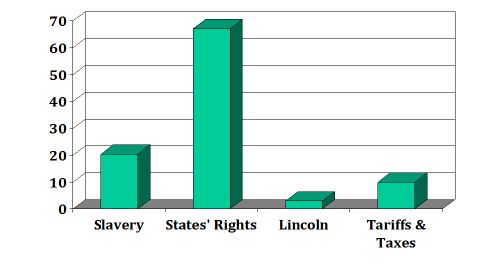
Essay 3: How to Teach Secession
Recognizing that inaccurate history often subtly promotes continuing white supremacy, the National Education Association (NEA) commissioned these articles and has posted some of them in slightly different form at its website. I thank Harry Lawson and others at NEA for the commission, for editorial suggestions, and for other assistance.
Since the sesquicentennial of secession in 2010, I have asked about 5,000 teachers across the country, “Why did the South secede?” 75% get it wrong, partly because most U.S. history textbooks mystify the topic. Yet the primary sources could not be clearer. This article will set the record straight while providing a way to help students discover the answer themselves.
Start by asking: Since the creation of the United States, what is the most important thing ever to happen to it? The answer has to be secession and the resulting Civil War.
Once they agree that the Civil War is #1, then ask, “Why did the South secede?” A serious conversation results, with audiences young or old. Four alternatives usually emerge:
- for slavery,
- for states’ rights,
- the election of Lincoln, and
- issues about tariffs and taxes.
Then ask students to vote. In my experience, until about 2016, regardless of region, 60% usually choose states’ rights, 20% slavery, another 15% tariffs and taxes, and one or two Lincoln. In some areas, the vote still comes out like that. If your students give one alternative a plurality, ask, “Is [that alternative] therefore the right answer? Is that how we do history? By majority vote?”

Students will chorus “No,” so you can follow up: “What do we need?” Hopefully they will reply “evidence” or “facts.” Ask them to pair up and come up with ideas as to good evidence. They will suggest newspapers, politicians’ diaries, and other primary sources. “Primary” refers to items from the time, contrasted with secondary sources like historical monographs and tertiary sources like textbooks. Set them free to unearth primary sources on the web. They will find that the early-seceding states did so by convention, which told why they were seceding. Always they stressed slavery.
For instance, the first “Declaration Of Causes,” South Carolina’s, quoted Article IV Section 2 of the Constitution, the fugitive slave clause, and then charged:
But an increasing hostility on the part of the non-slaveholding states to the institution of slavery has led to a disregard of their obligations, and the laws of the General Government… The States of Maine, New Hampshire … Wisconsin, and Iowa, have enacted laws which either nullify the acts of Congress, or render useless any attempt to execute them. In many of these States the fugitive is discharged from the service or labor claimed …
Clearly, South Carolina opposed states’ rights whenever Northern states exercised them on behalf of African Americans. Students will find nothing about tariffs and taxes, either. States did castigate Lincoln, because he opposed slavery. So it all comes back to the s-word.
Why is this important?
First, we must get history right. Once we abandon the truth, we start down a slippery slope with no principles to guide us as to what to teach. Second, misteaching secession denies the important role African Americans played. Those who escaped bondage from border states so jeopardized slavery that enslaved people in Maryland were worth much less than in Mississippi, partly because they were less secure. As well, every escape gave the lie to the ideology of racism that whites used to rationalize the institution: that slavery was appropriate for blacks and they liked it. Finally, making the Confederacy about states’ rights valorizes the neo-Confederate cause today.
Misteaching secession is one reason why the performance gap by race in social studies is greater than in any other field. It feeds the general alienation that some African Americans feel about school by implying that they never did much. And it underlies the affection for the Confederacy felt by some white Americans — Dylann Roof is an extreme example.
Essential Reading
- Loewen, “Five Myths About Why the South Seceded,” Washington Post, 1/9/2011, washingtonpost.com/outlook/five-myths-about-why-the-south-seceded/2011/01/03/ABHr6jD_story.html. Offers more detail showing that the South opposed states’ rights; also notes that the North did not go to war to end slavery but to hold the nation together.
All essays in the Correct(ed) series:
Introducing the Series
Essay 2: How to Teach Slavery
Essay 3: How to Teach Secession
Essay 4: Teaching about the Confederacy and Race Relations
Essay 5: Confederate Public History
Essay 6: Reconstruction
Essay 7: Getting History Right Can Decrease Racism Toward Mexican Americans
Essay 8: Problematic Words about Native Americans
Essay 9: How and When Did the First People Get Here?
Essay 10: The Pantheon of Explorers
Essay 11: Columbus Day
Essay 12: How Thanksgiving Helps Keep Us Ethnocentric
Essay 13: American Indians as Mascots
Essay 14: How to Teach the Nadir of Race Relations
Essay 15: Teaching the Civil Rights Movement
Essay 16: Getting Students Thinking about the Future